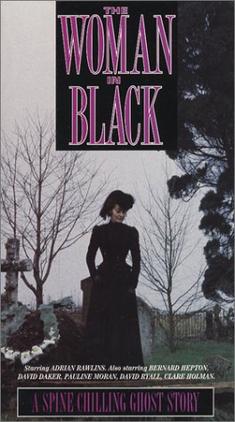Plot
In 1925, London solicitor Arthur Kidd travels to the coastal market town of Crythin Gifford on England's east coast to attend the funeral and settle the estate of their client Alice Drablow, a reclusive widow. Upon his arrival, he meets Sam Toovey, a local landowner. Kidd finds the townspeople reluctant to talk about Drablow's home, Eel Marsh House.
When Kidd attends the funeral with local solicitor Pepperell, he notices an apparent mourner, a woman in black, but Pepperell becomes frightened when Kidd mentions her. Later, Kidd saves the life of a Romani child when logs break free from a lumber truck as it is passing through the village.
A local coachman takes Kidd to Eel Marsh House, which can be accessed only by a tidal causeway that appears at low tide. He shows Kidd how to start the generator that powers the house's electric lighting. Left alone at the house, Kidd explores the family graveyard and sees the mysterious woman from the funeral, terrifying him. In the study, he finds two death certificates and photographs of a young woman resembling her, and listens to some disturbing recordings made by Mrs. Drablow on wax cylinders. A short time later, the coachman arrives to take him back to town.
Toovey tells him not to return to the house, but Kidd insists he will not be afraid this time. Toovey loans Kidd his dog Spider. On his return, Kidd hears the sound of a bouncing ball emanating from upstairs. Spider starts barking and leads Kidd to a locked door. Kidd gets an axe to break the door, only to find that it has opened by itself. Inside is an immaculately-kept child's nursery. Kidd hears the sounds of a child greeting him and opens his hand to find that he is somehow holding a lead soldier. The generator runs down and he rushes outside to restart it.
Outside, Spider answers a whistle and runs away into the night. Kidd once again hears the echoing sounds of the drowning horse, woman, and child in the marsh. Frightened almost into madness, he takes refuge in the house and records his fears onto the wax cylinders.
From Mrs. Drablow's papers, Kidd learns that Mrs. Drablow's sister, Jennet Goss, had a child out of wedlock. The Drablows adopted the boy to save face, insisting he should never know Jennet was his mother. Jennet kidnapped her son and tried to escape via the causeway, but the pony and trap became stuck in the marshes and sank, killing all aboard.
Toovey arrives at Eel Marsh House, brought by Spider. He reveals that seeing the Woman in Black presages the death of a child. Kidd shows Toovey the recordings and the nursery. However, the room is now mysteriously a mess, with all the toys smashed. Shocked, Kidd collapses.
Kidd awakens in the town inn to the sound of the child's laughter and finds the lead soldier yet again in his hand. After asking what the child wants, the Woman in Black appears and shrieks in his face, terrifying him into unconsciousness.
Kidd falls ill for a few days and the Tooveys look after him. When he recovers, he returns to London and his family. Back in the office, his two assistants say that there was a customer waiting for him, a woman dressed as a widow in black. Kidd searches madly through the box of Mrs. Drablow's papers for the toy soldier. When he does not find it, he burns the papers and the box, and ends up burning half his office as well. His boss fires him.
Later, Arthur and his family are boating on a lake when Arthur sees the Woman in Black standing on the surface of the water. A tree falls on their boat, crushing and drowning them all.
